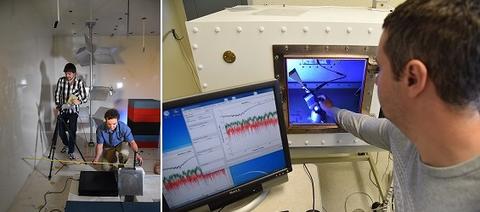Reverberation-Chamber Techniques for Wireless

Reverberation Chambers
The Metrology for Wireless Systems Group is supporting industry efforts to move reverberation chambers into the mainstream of over-the-air (OTA) wireless device testing. These highly reflective metallic chambers produce the sorts of cluttered, highly multipath real-world conditions in which future wireless systems will increasingly operate. Using reverberation chambers (as opposed to traditional anechoic chambers) also simplifies and boosts the efficiency of testing, saving industry time and money in characterizing today’s portable 4G devices – and tomorrow’s 5G and massive MIMO devices.
Specifically, we are:
- Refining OTA techniques for measuring large-form-factor wireless devices in reverberation chambers, including body-worn devices tested on human phantoms, and disseminating best-practice methods and uncertainties to the wireless industry.
- Supporting the current 4G cellular telecommunications industry by developing reverberation-chamber calibrations and uncertainties for MIMO-over-the-air test methods and disseminating these methods through CTIA certification working groups.
- Developing reverberation-chamber methods with uncertainties for measuring antenna efficiency and total radiated power at mmWave frequencies.
- Applying power- and phase-normalized wave parameters to the calibration of modulated-signal measurements in a reverberation chamber at mmWave frequencies for new, highly accurate modulated-signal radiated power measurements.
- Quantifying the effect on uncertainty of using a reference antenna that has different radiation characteristics than the unknown device-under-test (DUT) antenna (the “unknown K factor” problem).
- Investigating the use of reverberation chambers for testing massive MIMO wireless devices to provide a multipath-rich environment for repeatable, laboratory-based testing.
Contacts
RF Technology Division
-
(303) 497-3652
Created June 3, 2016, Updated March 26, 2020

